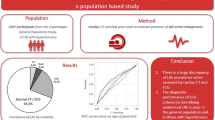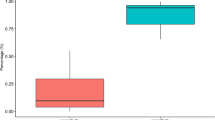Abstract
Left atrial enlargement (LAE) has adverse prognostic implications in hypertension. We sought to determine the accuracy of five electrocardiogram (ECG) criteria for LAE in hypertension relative to cardiac magnetic resonance (CMR) gold standard and investigate the effect of concomitant obesity. One hundred and thirty consecutive patients (age: 51.4±15.1 years, 47% male, 51% obese, systolic blood pressure (BP): 171±29 mm Hg, diastolic BP: 97±15 mm Hg) referred for CMR (1.5 T) from a tertiary hypertension clinic were included. Patients with concomitant cardiac pathology were excluded. ECGs were assessed blindly for the following: (1) P-wave >110 ms, (2) P-mitrale, (3) P-wave axis <30°, (4) area of negative P-terminal force in V1 >40 ms.mm and (5) positive P-terminal force in augmented vector left (aVL) >0.5 mm. Left atrial volume ≥55 ml m−2, measured blindly by CMR, was defined as LAE. Sensitivity, specificity, positive predictive value, negative predictive value, accuracy and area under the receiver operator curve were calculated. The prevalence of LAE by CMR was 26%. All the individual ECG LAE criteria were more specific than sensitive, with specificities ranging from 70% (P-axis <30o) to 99% (P-mitrale). Obesity attenuated the specificity of most of the individual ECG LAE criteria. Obesity correlated with significant lower specificity (48% vs 65%, P<0.05) and a trend towards lower sensitivity (59 vs 43%, P=0.119) when ≥1 ECG LAE criteria were present. Individual ECG criteria of LAE in hypertension are specific, but not sensitive, at identifying LAE. The ECG should not be used to excluded LAE in hypertension, particularly in obese subjects.
This is a preview of subscription content, access via your institution
Access options
Subscribe to this journal
Receive 12 digital issues and online access to articles
$119.00 per year
only $9.92 per issue
Buy this article
- Purchase on Springer Link
- Instant access to full article PDF
Prices may be subject to local taxes which are calculated during checkout


Similar content being viewed by others
References
Mancia G, Fagard R, Narkiewicz K, Redon J, Zanchetti A, Böhm M et al. 2013 ESH/ESC guidelines for the management of arterial hypertension: the Task Force for the Management of Arterial Hypertension of the European Society of Hypertension (ESH) and of the European Society of Cardiology (ESC). Eur Heart J 2013; 34 (28): 2159–2219.
Weber MA, Schiffrin EL, White WB, Mann S, Lindholm LH, Kenerson JG et al. Clinical practice guidelines for the management of hypertension in the community. J Clin Hypertens 2014; 16 (1): 14–26.
Alsaileek AA, Osranek M, Fatema K, McCully RB, Tsang TS, Seward JB . Predictive value of normal left atrial volume in stress echocardiography. J Am Coll Cardiol 2006; 47 (5): 1024–1028.
Gerdts E, Oikarinen L, Palmieri V, Otterstad JE, Wachtell K, Boman K et al. Correlates of left atrial size in hypertensive patients with left ventricular hypertrophy: the Losartan Intervention For Endpoint Reduction in Hypertension (LIFE) Study. Hypertension 2002; 39 (3): 739–743.
Tsang TSM, Barnes ME, Gersh BJ, Bailey KR, Seward JB . Risks for atrial fibrillation and congestive heart failure in patients >/=65 years of age with abnormal left ventricular diastolic relaxation. Am J Cardiol 2004; 93 (1): 54–58.
Barnes ME, Miyasaka Y, Seward JB, Gersh BJ, Rosales AG, Bailey KR et al. Left atrial volume in the prediction of first ischemic stroke in an elderly cohort without atrial fibrillation. Mayo Clin Proc 2004; 79 (8): 1008–1014.
Tsang TSM, Abhayaratna WP, Barnes ME, Miyasaka Y, Gersh BJ, Bailey KR et al. Prediction of cardiovascular outcomes with left atrial size: is volume superior to area or diameter? J Am Coll Cardiol 2006; 47 (5): 1018–1023.
Modena MG, Muia N, Sgura FA, Molinari R, Castella A, Rossi R . Left atrial size is the major predictor of cardiac death and overall clinical outcome in patients with dilated cardiomyopathy: a long-term follow-up study. Clin Cardiol 1997; 20 (6): 553–560.
Hazen MS, Marwick TH, Underwood DA . Diagnostic accuracy of the resting electrocardiogram in detection and estimation of left atrial enlargement: an echocardiographic correlation in 551 patients. Am Heart J 1991; 122 (3 Pt 1): 823–828.
Munuswamy K, Alpert MA, Martin RH, Whiting RB, Mechlin NJ . Sensitivity and specificity of commonly used electrocardiographic criteria for left atrial enlargement determined by M-mode echocardiography. Am J Cardiol 1984; 53 (6): 829–832.
van Dam I, Roelandt J, Robles de Medina EO . Left atrial enlargement: an electrocardiographic misnomer? An electrocardiographic-echocardiographic study. Eur Heart J 1986; 7 (2): 115–117.
Waggoner AD, Adyanthaya AV, Quinones MA, Alexander JK . Left atrial enlargement. Echocardiographic assessment of electrocardiographic criteria. Circulation 1976; 54 (4): 553–557.
Lester SJ, Ryan EW, Schiller NB, Foster E . Best method in clinical practice and in research studies to determine left atrial size. Am J Cardiol 1999; 84 (7): 829–832.
Tsao CW, Josephson ME, Hauser TH, O’Halloran TD, Agarwal A, Manning WJ et al. Accuracy of electrocardiographic criteria for atrial enlargement: validation with cardiovascular magnetic resonance. J Cardiovasc Magn Reson 2008; 10: 7.
Bureekam S, Boonyasirinant T . Accuracy of left atrial enlargement diagnosed by electrocardiography as compared to cardiac magnetic resonance in hypertensive patients. J Med Assoc Thai 2014; 97 (Suppl 3): S132–S138.
Lang RM, Bierig M, Devereux RB, Flachskampf FA, Foster E, Pellikka PA et al. Recommendations for chamber quantification. Eur J Echocardiogr 2006; 7 (2): 79–108.
Järvinen VM, Kupari MM, Hekali PE, Poutanen VP . Right atrial MR imaging studies of cadaveric atrial casts and comparison with right and left atrial volumes and function in healthy subjects. Radiology 1994; 191 (1): 137–142.
Järvinen VM, Kupari MM, Poutanen VP, Hekali PE . Right and left atrial phasic volumetric function in mildly symptomatic dilated and hypertrophic cardiomyopathy: cine MR imaging assessment. Radiology 1996; 198 (2): 487–495.
Therkelsen SK, Groenning BA, Svendsen JH, Jensen GB . Atrial and ventricular volume and function in persistent and permanent atrial fibrillation, a magnetic resonance imaging study. J Cardiovasc Magn Reson 2005; 7 (2): 465–473.
Tseng W-YI, Liao T-Y, Wang J-L . Normal systolic and diastolic functions of the left ventricle and left atrium by cine magnetic resonance imaging. J Cardiovasc Magn Reson 2002; 4 (4): 443–457.
Movahed MR, Saito Y . Obesity is associated with left atrial enlargement, E/A reversal and left ventricular hypertrophy. Exp Clin Cardiol 2008; 13 (2): 89–91.
Rodrigues JCL, Amadu AM, Dastidar AG, Hassan N, Lyen SM, Lawton CB et al. Prevalence and predictors of asymmetric hypertensive heart disease: insights from cardiac and aortic function with cardiovascular magnetic resonance. Eur Heart J Cardiovasc Imaging. (e-pub ahead of print 24 December 2015; doi:10.1093/ehjci/jev329).
World Health Organization. Obesity and overweight. 2015. www.who.int/mediacentre/factsheets/fs311/en/. Accessed 20 May 2016.
Perosio AM, Suarez LD, Torino A, Llera JJ, Ballester A, Roisinblit JM . Reassessment of electrovectorcardiographic signs of left atrial enlargement. Clin Cardiol 1982; 5 (12): 640–646.
Ikram H, Drysdale P, Bones PJ, Chan W . The non-invasive recognition of left atrial enlargement: comparison of electro- and echocardiographic measurements. Postgrad Med J 1977; 53 (621): 356–359.
Kaminski M, Steel K, Jerosch-Herold M, Khin M, Tsang S, Hauser T et al. Strong cardiovascular prognostic implication of quantitative left atrial contractile function assessed by cardiac magnetic resonance imaging in patients with chronic hypertension. J Cardiovasc Magn Reson 2011; 13 (1): 42.
Hudsmith LE, Petersen SE, Francis JM, Robson MD, Neubauer S . Normal human left and right ventricular and left atrial dimensions using steady state free precession magnetic resonance imaging. J Cardiovasc Magn Reson 2005; 7 (5): 775–782.
Sievers B, Kirchberg S, Addo M, Bakan A, Brandts B, Trappe H-J . Assessment of left atrial volumes in sinus rhythm and atrial fibrillation using the biplane area-length method and cardiovascular magnetic resonance imaging with TrueFISP. J Cardiovasc Magn Reson 2004; 6 (4): 855–863.
Maceira A, Prasad S, Khan M, Pennell D . Normalized left ventricular systolic and diastolic function by steady state free precession cardiovascular magnetic resonance. J Cardiovasc Magn Reson 2006; 8 (3): 417–426.
Rodrigues JCL, McIntyre B, Dastidar AG, Lyen SM, Ratcliffe LE, Burchell AE et al. The effect of obesity on electrocardiographic detection of hypertensive left ventricular hypertrophy: recalibration against cardiac magnetic resonance. J Hum Hypertens 2016; 30 (3): 197–203.
Childs H, Ma L, Ma M, Clarke J, Cocker M, Green J et al. Comparison of long and short axis quantification of left ventricular volume parameters by cardiovascular magnetic resonance, with ex-vivo validation. J Cardiovasc Magn Reson 2011; 13 (1): 40.
Cuspidi C, Rescaldani M, Sala C . Prevalence of echocardiographic left-atrial enlargement in hypertension: a systematic review of recent clinical studies. Am J Hypertens 2013; 26 (4): 456–464.
Myerson SG, Bellenger NG, Pennell DJ . Assessment of left ventricular mass by cardiovascular magnetic resonance. Hypertension 2002; 39 (3): 750–755.
Wachtell K, Gerdts E, Aurigemma GP, Boman K, Dahlöf B, Nieminen MS et al. In-treatment reduced left atrial diameter during antihypertensive treatment is associated with reduced new-onset atrial fibrillation in hypertensive patients with left ventricular hypertrophy: the LIFE Study. Blood Press 2010; 19 (3): 169–175.
Gottdiener JS, Reda DJ, Williams DW, Materson BJ, Cushman W, Anderson RJ . Effect of single-drug therapy on reduction of left atrial size in mild to moderate hypertension: comparison of six antihypertensive agents. Circulation 1998; 98 (2): 140–148.
Lee KS, Appleton CP, Lester SJ, Adam TJ, Hurst RT, Moreno CA et al. Relation of electrocardiographic criteria for left atrial enlargement to two-dimensional echocardiographic left atrial volume measurements. Am J Cardiol 2007; 99 (1): 113–118.
Anderson JL, Horne BD, Pennell DJ . Atrial dimensions in health and left ventricular disease using cardiovascular magnetic resonance. J Cardiovasc Magn Reson 2005; 7 (4): 671–675.
Rodevan O, Bjornerheim R, Ljosland M, Maehle J, Smith HJ, Ihlen H . Left atrial volumes assessed by three- and two-dimensional echocardiography compared to MRI estimates. Int J Card Imaging 1999; 15 (5): 397–410.
Stritzke J, Markus MRP, Duderstadt S, Lieb W, Luchner A, Döring A et al. The aging process of the heart: obesity is the main risk factor for left atrial enlargement during aging the MONICA/KORA (monitoring of trends and determinations in cardiovascular disease/cooperative research in the region of Augsburg) study. J Am Coll Cardiol 2009; 54 (21): 1982–1989.
Horton JD, Sherber HS, Lakatta EG . Distance correction for precordial electrocardiographic voltage in estimating left ventricular mass: an echocardiographic study. Circulation 1977; 55 (3): 509–512.
Levy D, Labib SB, Anderson KM, Christiansen JC, Kannel WB, Castelli WP . Determinants of sensitivity and specificity of electrocardiographic criteria for left ventricular hypertrophy. Circulation 1990; 81 (3): 815–820.
Di Bianco R, Gottdiener JS, Fletcher RD, Pipberger HV . Left atrial overload: a hemodynamic, echocardiographic, electrocardiographic and vectorcardiographic study. Am Heart J 1979; 98 (4): 478–489.
Josephson ME, Kastor JA, Morganroth J . Electrocardiographic left atrial enlargement. Electrophysiologic, echocardiographic and hemodynamic correlates. Am J Cardiol 1977; 39 (7): 967–971.
Acknowledgements
This work was part-funded by the NIHR Bristol Cardiovascular Biomedical Research Unit, Bristol Heart Institute. We thank Mr Christopher Lawton, CMR Superintendent Radiographer and the CMR radiographer team within in the Bristol Heart Institute for their expertise in acquiring the CMR studies. The views expressed in this manuscript are those of the authors and not necessarily reflect those of the National Health Service, National Institute for Health Research or Department of Health. JCLR is funded by the Clinical Society of Bath Postgraduate Research Bursary 2014 and Royal College of Radiologists Kodak Research Scholarship 2014. ECH (BHF grant IBSRF FS/11/1/28400) and JRFP are both funded by the British Heart Foundation.
Author information
Authors and Affiliations
Corresponding author
Ethics declarations
Competing interests
The authors declare no conflict of interest.
Rights and permissions
About this article
Cite this article
Rodrigues, J., Erdei, T., Dastidar, A. et al. Electrocardiographic detection of hypertensive left atrial enlargement in the presence of obesity: re-calibration against cardiac magnetic resonance. J Hum Hypertens 31, 212–219 (2017). https://doi.org/10.1038/jhh.2016.63
Received:
Revised:
Accepted:
Published:
Issue Date:
DOI: https://doi.org/10.1038/jhh.2016.63



